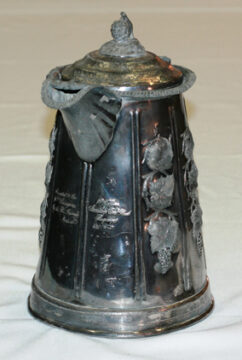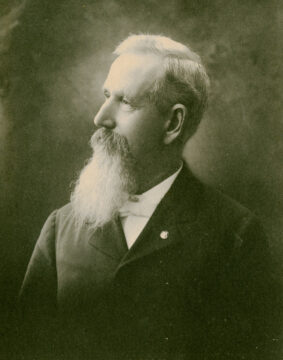
This month, Rosenberg Library displayed an antique water pitcher presented to Galveston resident William Scrimgeour 155 years ago on March 15, 1861. Scrimgeour served as first officer of the Confederate steamship General Rusk during the Civil War. He later became a bar pilot and the harbormaster for Galveston. The presentation pitcher was donated to the Rosenberg Library by his grandson, William Manning Morgan.
General Rusk
The General Rusk was built in Wilmington, Delaware in 1857 and was a merchant ship before being acquired by the Confederacy at the beginning of the American Civil War. In 1861, she was brought to Texas to serve as a signal boat in Galveston harbor. William Scrimgeour became the second-in-command of this vessel under Commodore Leon Smith.
The pitcher which is part of the library’s museum collection bears the inscription: “Presented to the First Officer / Wm. Scrimgeour / Steamship Gen. Rusk / By the Rio Grande Regiment / March 15th 1861.” The Rio Grande Regiment was a volunteer brigade of 500 men organized in Galveston under the command of John S. “RIP” Ford. In February 1861, these men sailed to the mouth of the Rio Grande River onboard General Rusk and two other ships to seize military supplies from the U.S. Army. They successfully secured the Federal arsenal in what was the first real action of the Civil War in the state of Texas. The presentation pitcher was given to William Scrimgeour following this military triumph.
In April 1861, intelligence reached Galveston that Federal vessels were stationed at Indianola — a major port on Matagorda Bay — for the purpose of picking up seven companies of U.S. troops who had marched there from San Antonio to be transported to the North. A plan was devised by Confederate Colonel Earl Van Dorn to intercept and capture these troops as well as the Union steamship Star of the West.
On April 17, 1861, the captain of General Rusk approached Star of the West and stated that he was carrying Federal troops onboard who were waiting to be transported. The unsuspecting captain of Star of the West invited sailors from the General Ruskto board his ship before they identified themselves as the enemy and demanded custody of the ship. As they were caught off guard and outnumbered, the crew of Star of the West surrendered without resistance, and the vessel was peacefully overtaken by the Confederates.
Meriden Britannia Company
The presentation pitcher remained in the possession of William Scrimgeour throughout his life and was passed down to his daughter, Jean Scrimgeour Morgan, and later to her son, William Manning Morgan who gifted it to the Library as part of the Morgan Memorial Collection.
In addition to its significance in terms of Civil War history, the pitcher is important in terms of its manufacturing history. It was produced by the Meriden Brittania Company in Meriden, Connecticut. Britannia — a metal similar to pewter — is a type of silver plate that was developed in the early 1800s. Britannia was thinner and stronger than pewter, was more affordable to manufacture, and was more resistant to tarnish. This combination made it extremely popular in America.
Brittania is derived through a technique known as “electro-plating” which involves depositing a thin layer of silver onto a base metal and using an electric current passed through a conductive liquid to fuse the two together. This offered a significantly less expensive alternative to pure silver while possessing the same exterior luster and durability.
The pitcher presented to William Scrimgeour was specifically for ice water and would have been a luxurious and highly specialized type of ware in the mid-19th century. It featured a “double-wall” design that was patented just a few years earlier. This innovative technique allowed for better insulation to prevent the ice from melting and to keep the water colder for an extended period. The pitcher consists of a metal inner lining with a hollow space between it and the outer body of the vessel, much like a thermos. The patent date for the Meriden pitcher was 1858, so the technology was still a recent advancement when the pitcher was presented to William Scrimgeour three years later.

William Scrimgeour
Born in New York in 1836, William Scrimgeour left home at a young age to pursue a life of adventure on the high seas. After sailing around the world on three separate voyages, he settled in the port city of Galveston in 1857. At age 21, he joined the Confederate cause during the Civil War and after serving as lieutenant of General Rusk took command of the Confederate blockade-runner Alice. Alice cruised between the ports of Galveston, New Orleans, Key West, and Havana. While on his way back to Galveston from Havana in 1864, Scrimgeour was captured by Federal officials and taken as a prisoner of war to Fort Warren in Boston Harbor. He was held there for 18 months until negotiations were reached to exchange him for another prisoner.
He eventually returned to Galveston where he joined the Morgan Steamship Lines and served as a bar pilot for thirty years. William Scrimgeour and his wife, Josephine, had three children — Charles, William, and Jean. The family lived in an elegant residence at 810 Postoffice on the East End. Scrimgeour died at his home in January of 1919 at age 83.